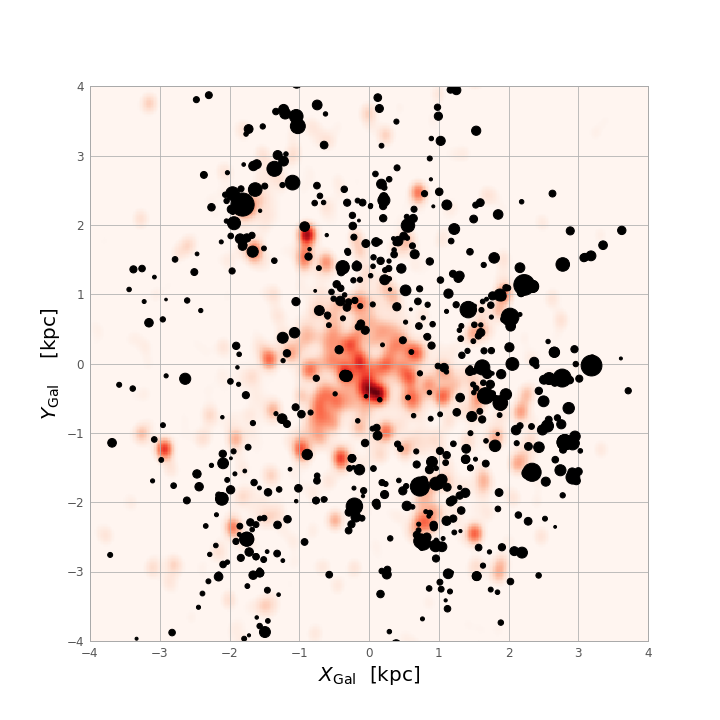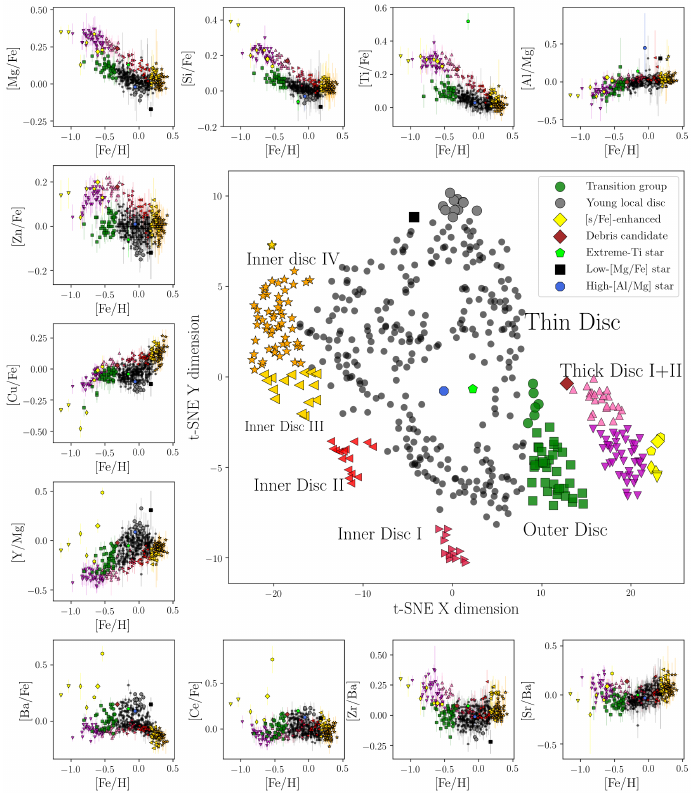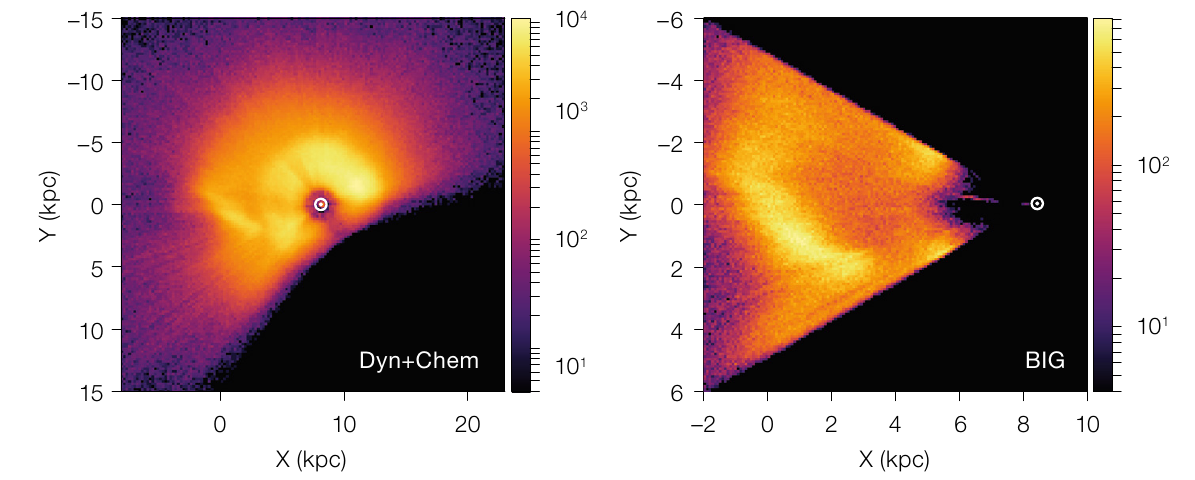Galactic Archaeology
The main challenge of Galactic archaeology is to unravel the Milky Way’s assembly and evolution history by determining ages, chemical compositions, and kinematics of millions of stars covering all parts of the Milky Way. Major observing campaigns of the last decade, and the success of the Gaia mission, have assured that this is in principle possible: precise radial velocities as well as basic chemical information for millions of stars have already been obtained by surveys such as RAVE, APOGEE, LAMOST, or GALAH. The Gaia mission, on the other hand, allows us to measure parallaxes and transverse kinematics for billions of stars for the first time with unprecedented precision; the third Gaia data release from 2023 provides a new testbench for the next-generation Milky-Way models.
As an example of how these large datasets help us to decipher the chemo-dynamical history of the Milky Way, here is a recently obtained age map of our Galaxy, superimposed on an image of the nearby edge-on disc galaxy NGC 891 (from Anders et al. 2023):

Anders, F., Padois, C.; Vilanova Sar, M.; Semczuk, M., del Alcázar-Julià, Figueras, F. (2025), On the age distribution of Classical Cepheids in the Galaxy, Astronomische Nachrichten, 346, id.e70009
Anders, F., Gispert, P.; Ratcliffe, B.; et al. (2023), Spectroscopic age estimates for APOGEE red-giant stars: Precise spatial and kinematic trends with age in the Galactic disc , A&A, 678, A158
Minchev, I.; Anders, F., Recio-Blanco, A.; et al. (2018), Estimating stellar birth radii and the time evolution of Milky Way's ISM metallicity gradient, MNRAS, 481, 1, 645
Anders, F., Chiappini, C.; Minchev, I.; et al. (2017), Red giants observed by CoRoT and APOGEE: The evolution of the Milky Way's radial metallicity gradient, A&A, 600, A70
Anders, F., Chiappini, C.; Santiago, B. X.; et al. (2014), Chemodynamics of the Milky Way. I. The first year of APOGEE data , A&A, 564, A115
Main collaborators: GaiaUB group (Teresa Antoja, Chloé Padois, Judith Ardèvol, Francesca Figueras, Marcin Semczuk, Marc del Alcázar-Julià, Mercè Romero-Gómez), UB students, AIP Milky Way & Local Volume group (Cristina Chiappini, Samir Nepal, Ivan Minchev, Bridget Ratcliffe, Matthias Steinmetz), Anna Queiroz (IAC Tenerife), Laia Casamiquela (Obs Paris), Andrea Miglio (U Bologna), Annie Robin (Obs Besançon), and the Milky Way Brazilian Group (e.g. Hélio Perottoni (Observatório Nacional Rio de Janeiro), Joao Amarante (Shanghai Jiaotong University), Lais Borbolato (IAG Sao Paulo), Guilherme Limberg (U Chicago))
Star clusters
Open clusters are groups of a dozen to several thousands of stars that were born together from the same parent molecular cloud, and remained bound by gravity. Their distances and ages can be estimated more easily than for individual stars, and they can be used to trace the structure of our Galaxy. ESA's Gaia mission provides us with precise measurements of parallaxes and proper motions that can be used to identify compact groups of stars traveling together through the Galaxy. Most of these newly discovered clusters cannot be seen in static images of the sky, but can easily be spotted using the Gaia measurements of distance and velocity. In Gaia's second data release (DR2) we found hundreds of new open clusters, as beautifully illustrated in this Gaia image of the week):

Hunt, E., Cantat-Gaudin, T., Anders, F., et al. (2025), The completeness of the open cluster census towards the Galactic anticentre , A&A, 699, A273
Carbajo-Hijarrubia, J., Carrera, R., Anders, F., et al. (2025), Open clusters in the outer disc studied with GTC/MEGARA: Auner 1 and Berkeley 102 , A&A, 699, A269
Donada, J., Anders, F., Jordi, C., Masana, E., et al. (2023), The multiplicity fraction in 202 open clusters from Gaia , A&A, 675, A89
Anders, F., Castro-Ginard, A., Casado, J., Jordi, C., Balaguer-Núñez, L. (2022), NGC 1605 is not a binary cluster , AAS Research Notes, 6, 58
Anders, F., Cantat-Gaudin, T., Quadrino-Lodoso, I., Gieles, M., Jordi, C., Castro-Ginard, A., Balaguer-Núñez, L. (2021), The star cluster age function in the Galactic disc with Gaia DR2: Fewer old clusters and a low cluster formation efficiency , A&A Letters, 645, L2
Cantat-Gaudin, T., Anders, F., Castro-Ginard, A., Jordi, C., Romero-Gómez, M., et al. (2020), Painting a portrait of the Galactic disc with its stellar clusters, A&A, 640, A1
Cantat-Gaudin, T., Anders, F. (2020), Clusters and mirages: cataloguing stellar aggregates in the Milky Way , A&A, 633, A99
Main collaborators: GaiaUB group (Sagar Malhotra, Judit Donada, Lola Balaguer-Núñez, Nooshineh Zabihi, Alfred Castro-Ginard, Andrija Župić, Xavi Luri, Carme Jordi, Juan Carbajo, Josep-Manel Carrasco, Eduard Masana), UB students, Laia Casamiquela (Obs Paris), Songmei Qin (SHAO Shanghai), Tristan Cantat-Gaudin (MPIA Heidelberg), Emily Hunt (LSW/ZAH Heidelberg), Mark Gieles (ICREA/ICCUB Barcelona), Ricardo Carrera (INAF Bologna)
Data mining and machine learning
The sample sizes and the number of available stellar chemical abundances have reached dimensions in which it has become difficult to process all the available information in an effective manner. Dimensionality reduction and unsupervised learning techniques can be used to analyse the stellar abundance-space distribution. As an example, here is a t-SNE view of the solar vicinity's stellar abundance space (from Anders et al. 2018):

Khalatyan, A., Anders, F., Chiappini, C.; et al. (2024), Transferring spectroscopic stellar labels to 217 million Gaia DR3 XP stars with SHBoost, A&A, 691, A98
Castro-Ginard, A.; Jordi, C.; Luri, X.; Cantat-Gaudin, T. ; Carrasco, J. M.; Casamiquela, L.; Anders, F.; Balaguer-Núñez, L.; Badia, R. M. (2022), Hunting for open clusters in Gaia EDR3: 664 new open clusters found with OCfinder, A&A, 661, A118
Casamiquela, L.; Castro-Ginard, A., Anders, F., Soubiran, C. (2021), The (im)possibility of strong chemical tagging, A&A, 654, A151
Perottoni, H. D.; Amarante, J. A. S.; Limberg, G.; Rocha-Pinto, H. J.; Rossi, S., Anders, F., Borbolato, L. (2021), Searching for Extragalactic Exoplanetary Systems: the Curious Case of BD+20 2457, ApJL, 913, L3
Ramos, P., Antoja, T., Mateu, C., Anders, F., Laporte, C. F. P., Carballo-Bello, J. A., Famaey, B., Ibata, R. (2020), The outer disc in shambles: Blind detection of Monoceros and the ACS with Gaia's astrometric sample, A&A, 646, A99
Anders, F., Chiappini, C., Santiago, B. X., et al. (2018), Dissecting stellar chemical abundance space with t-SNE , A&A, 619, A125
Main collaborators: Arman Khalatyan (AIP), GaiaUB group (Sagar Malhotra, Alfred Castro-Ginard, Xavi Luri, Teresa Antoja, Michael Weiler, Andrija Župić), Christian Herenz (IUCAA Pune), Laia Casamiquela (Obs Paris), Pau Ramos (NAOJ Japan), Cristina Chiappini (AIP), Hélio Perottoni (ON Rio de Janeiro), Joao Amarante (Shanghai Jiaotong University), Guillaume Guiglion (ZAH Heidelberg), Guillermo Torralba (CIGUS A Coruña / U de La Rioja), Óscar Jiménez-Arranz (Obs Lund)
Mapping the Milky Way with the StarHorse code
Stellar distances and ages for millions of stars are needed to understand the chemo-dynamical history of Galaxy. The StarHorse code is a flexible python tool that enables us to determine precise stellar parameters, distances, and line-of-sight extinctions for millions of field stars with good Gaia parallaxes. I have been co-developing it for the past 10 years together with Anna Queiroz. The Gaia data, combined with ground- and space-based photometric surceys, also allowed us to study the three-dimensional distribution of stars beyond the parallax horizon, clearly revealing structures like the Galactic bar in stellar density maps ( ESA Press Release):

Tomasetti, E.; Chiappini, C.; Nepal, S.; Moresco, M.; Lardo, C.; Cimatti, A.; Anders, F.; Queiroz, A., Limberg, G. (2025), The oldest Milky Way stars: New constraints on the age of the Universe and the Hubble constant, A&A, subm.
Queiroz, A. B. A.; Anders, F.; Chiappini, C.; et al. (2023), StarHorse results for spectroscopic surveys + Gaia DR3: Ages for MSTO and subgiants and chemical substructures in the solar vicinity, A&A, 673, A155
Anders, F.; Khalatyan, A.; Queiroz, A. B. A.; et al. (2021), Photo-astrometric distances, extinctions, and astrophysical parameters for Gaia EDR3 stars brighter than G = 18.5, A&A, 658, A91
Queiroz, A. B. A.; Anders, F.; Chiappini, C.; et al. (2020), From the bulge to the outer disc: StarHorse stellar parameters, distances, and extinctions for stars in APOGEE DR16 and other spectroscopic surveys, A&A, 638, A76
Anders, F.; Khalatyan, A.; Chiappini, C.; et al. (2019), Photo-astrometric distances, extinctions, and astrophysical parameters for Gaia DR2 stars brighter than G = 18, A&A, 628, A94
Queiroz, A. B. A.; Anders, F., Santiago, B. X.; et al. (2018), StarHorse: a Bayesian tool for determining stellar masses, ages, distances, and extinctions for field stars, MNRAS, 476, 2, 2556
The StarHorse core team is presently composed of Anna Queiroz (IAC Tenerife), Cristina Chiappini (AIP Potsdam), Samir Nepal (AIP), Arman Khalatyan (AIP), Guilherme Limberg (U Chicago), and myself.
Contribution to ongoing and future stellar surveys
The StarHorse catalogues and my expertise in isochrone fitting, survey data analysis, and open clusters have allowed me to contribute to some ambitious projects of the Galactic astronomy community. I have been involved in the final science analysis of the RAVE survey, the production of value-added catalogues for the SDSS/APOGEE survey, observations and analysis for the OCCASO survey, and the preparation for the 4MOST Disc & Bulge Survey surveys (4MIDABLE). Currently I am spending some time on validating the upcoming Gaia data release 4, as part of the Gaia DPAC team.

SDSS Collaboration; Adamane Pallathadka, G.; ..., Anders, F., et al. (2025), The Nineteenth Data Release of the Sloan Digital Sky Survey , ApJS, subm.
Carbajo-Hijarrubia, J.; Casamiquela, L.; Carrera, R.; Balaguer-Núñez, L.; Jordi, C.; Anders, F., et al. (2024), OCCASO V. Chemical-abundance trends with Galactocentric distance and age, A&A, 687, A239
Gaia Collaboration; Vallenari, A.; Brown, A. G. A.; ...; Anders, F., et al. (2023), Gaia Data Release 3: Summary of the content and survey properties , A&A, 674, A1
Babusiaux, C.; Fabricius, C.; Khanna, S., ...; Anders, F., et al. (2023), Gaia Data Release 3: Catalogue Validation , A&A, 674, A32
Abdurro'uf; Accetta, K.; Aerts, C.; ..., Anders, F., et al. (2022), The 17th Data Release of the Sloan Digital Sky Surveys: Complete Release of MaNGA, MaStar and APOGEE-2 Data, ApJS, 259, 35
Chiappini, C.; Minchev, I.; Starkenburg, E.; Anders, F.; et al. (2019), 4MOST Consortium Survey 3: Milky Way Disc and Bulge Low-Resolution Survey (4MIDABLE-LR), The ESO Messenger, 175, 30
de Jong, R. S.; Agertz, O.; Berbel, A. A.; Aird, J.; Alexander, D. A.; Amarsi, A.; Anders, F.; et al. (2019), 4MOST: Project overview and information for the First Call for Proposals, The ESO Messenger, 175, 3